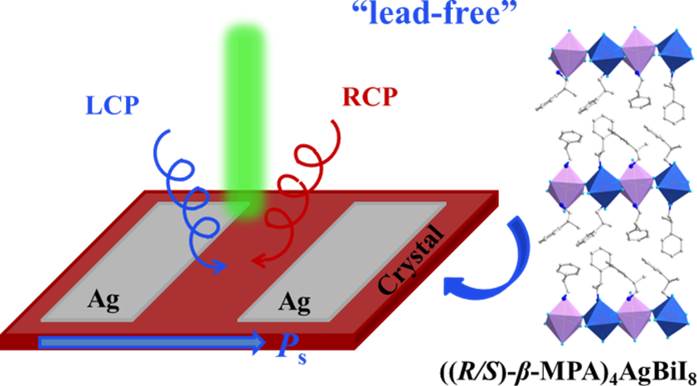
The metal-halide perovskites feature the distinctive structure flexibility, which enables the employment of chiral organic cations to construct chiral perovskites. Such chiral perovskites are the promising alternative for circular polarized light (CPL) detection owing to their efficient charge transport of inorganic frameworks and CPL-sensitive property induced by chiral organics.
In a study published in Angew. Chem. In. Ed., the research group led by Prof. LUO Junhua from Fujian Institute of Research on the Structure of Matter (FJIRSM) of the Chinese Academy of Sciences (CAS) reported two chiral lead-free hybrid perovskites.
The researchers obtained such chiral lead-free hybrid double perovskites by rationally assembling chiral organic cation with Ag+ and Bi3+ double metals.
Circular dichroism measurements revealed that these perovskites exhibit obvious circular dichroism signals locating around their characteristic absorption peak, indicating the directly transfer of chirality from organic cations to perovskite network.
The integration of semiconducting property and chirality enables the two chiral lead-free hybrid perovskites to present obviously unidentical photoresponse under illumination of right-handed and left-handed CPL at 520 nm.
In addition, chiral polar photovoltaic was realized for these chiral perovskites. Such polar photovoltaic endowed an unprecedented self-powered CPL detection without an external power source.
Furthermore, an anisotropy factor up to 0.3 was applied for the self-powered CPL detection. It should be the first lead-free halide double perovskite for CPL detection.
The study on CPL detection of lead-free halide double perovskite provides an efficient way for exploring high-performance “green” CPL photodetectors.

Schematic representation of CPL detection by lead-free halide double perovskites (Image by Prof. LUO’s Group)

86-10-68597521 (day)
86-10-68597289 (night)

52 Sanlihe Rd., Xicheng District,
Beijing, China (100864)

